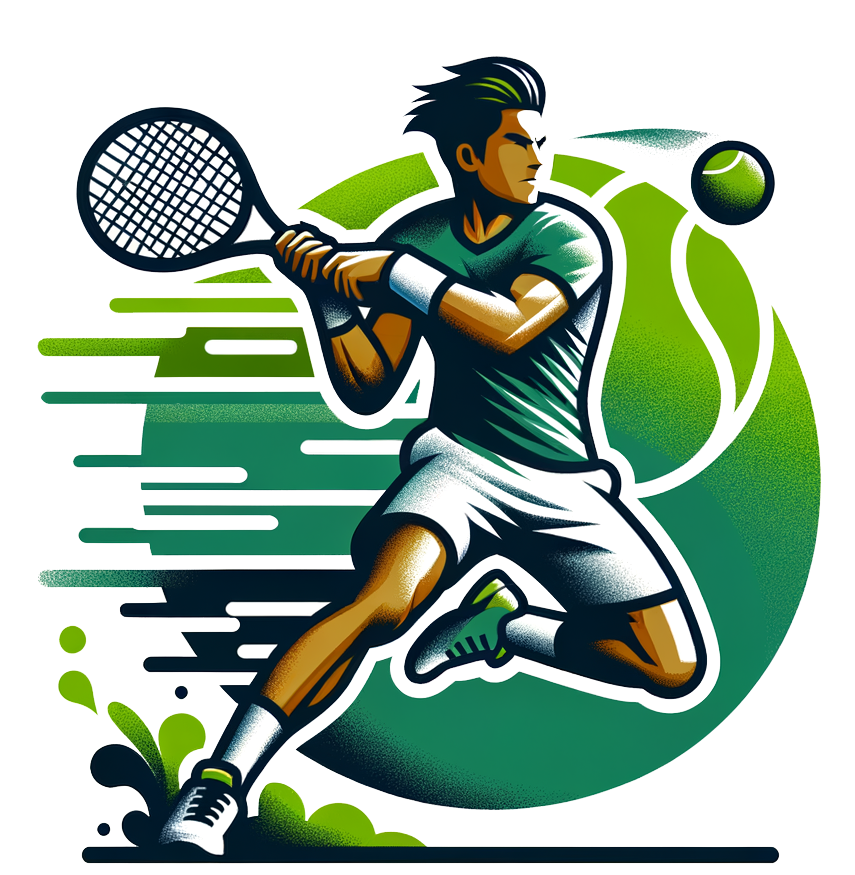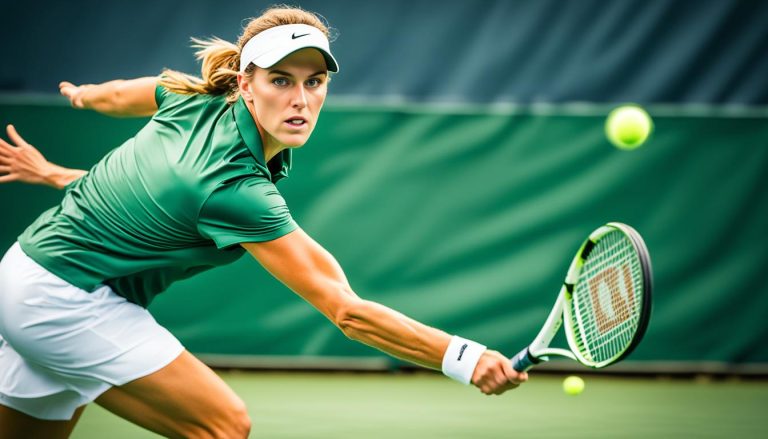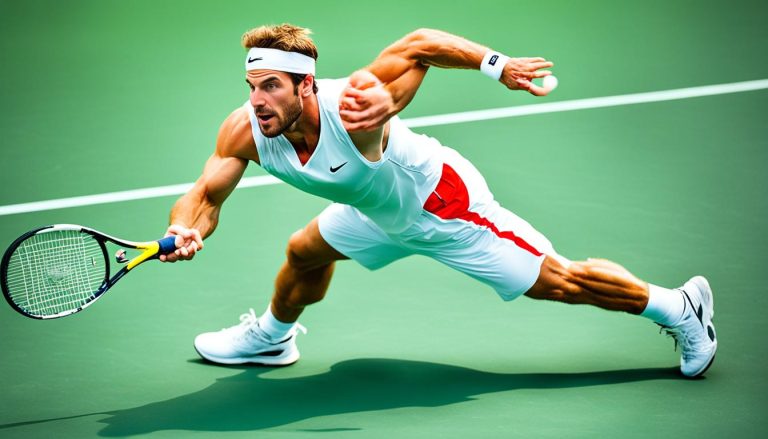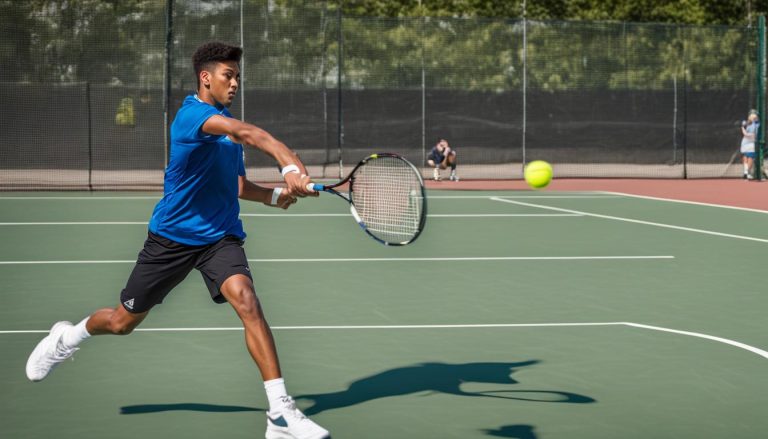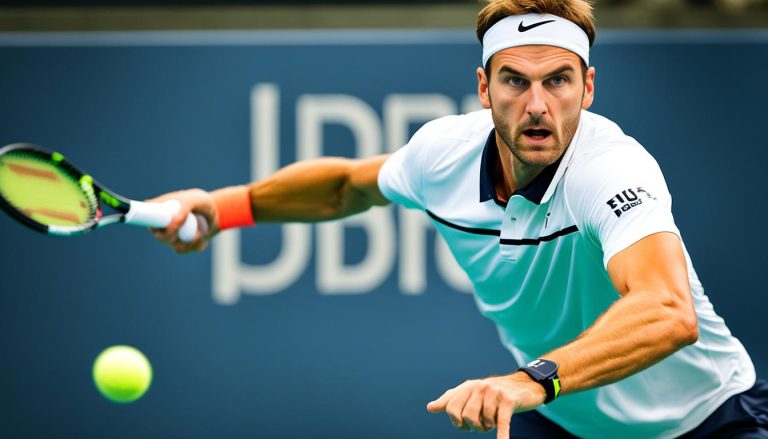Step-by-Step: Developing a Strong Backhand in Tennis
When it comes to tennis, a strong backhand is essential for players at all levels. Whether you’re just starting out or aiming to take your game to the next level, honing your backhand skills is crucial. In this comprehensive guide, Elliott Pettit, a USTA Player Development coach, shares step-by-step tips to help you develop a powerful and effective backhand in tennis. From beginners to advanced players, these techniques will enhance your racquet skills and elevate your performance on the court.
Before diving into the specific tips, it’s important to note that the backhand stroke can vary depending on the player’s preference, stance, and grip. However, there are certain fundamental principles that apply to all backhand techniques.
The key areas of focus include:
- Contact point
- Racquet-face control
- Grip
- Swing
- Footwork
By paying attention to these key aspects, you’ll be able to develop a strong backhand that will add power, accuracy, and versatility to your overall game.
Backhand Basics: Tennis Backhand Tips For Beginners
For beginners looking to improve their backhand in tennis, there are several key techniques and tips to keep in mind. By focusing on these backhand basics, beginners can build a solid foundation for their strokes and develop a more effective and reliable shot. So, let’s discover some essential tips to enhance your backhand game.
Grip: Find Your Comfort Zone
First and foremost, it’s crucial to find a grip that feels comfortable and allows for proper control of the racket. Beginners often start with a continental or Eastern grip, which provides stability and versatility for both forehand and backhand shots. Experiment with different grips and choose the one that feels most natural to you.
Contact Point: Slight Off to the Left Side
When making contact with the ball, try to aim slightly off to the left side for right-handed players (and right side for left-handed players). This positioning enables better control and helps generate topspin on the shot, allowing the ball to clear the net with accuracy and depth.
Racquet-Face Control: Keep it Firm
During the contact phase, it’s essential to maintain control of the racquet face. By keeping the racquet face slightly closed, beginners can minimize mishits and improve consistency. Practice keeping the face of the racquet steady and perpendicular to the ground when making contact with the ball.
Swing: Consistency is Key
Developing a consistent swing is crucial in mastering the backhand stroke. Beginners should focus on smooth and controlled swings, keeping the motion compact and following through with the racket. With practice, this will lead to better timing, accuracy, and power in your backhand shots.
Footwork: Light and Agile
Effective footwork is essential for maintaining balance and agility on the court. Beginners should strive to be light on their feet, staying on the balls of their feet and using quick, small steps to position themselves for the shot. Good footwork allows you to adjust to different ball placements and ensure a solid foundation for a strong backhand.
With these backhand basics and tips in mind, beginners can begin their journey towards developing a solid and reliable backhand stroke. Regular practice, patience, and a focus on the fundamentals will contribute to the overall improvement of your tennis game.
Now, let’s take a look at a visual representation of the backhand basics with this table:
| Backhand Basics | Description |
|---|---|
| Grip | Experiment with different grips to find the one that feels comfortable and allows for optimal control. |
| Contact Point | Aim slightly off to the left side (for right-handed players) to generate topspin and improve control. |
| Racquet-Face Control | Keep the racquet face slightly closed for better consistency and minimize mishits. |
| Swing | Focus on developing a consistent and controlled swing to improve timing, accuracy, and power. |
| Footwork | Stay light on your feet, using quick and small steps to maintain balance and agility on the court. |
By incorporating these backhand basics into your practice routine, you’ll be well on your way to improving your backhand and taking your tennis game to the next level.
Put a New Spin on It: Tennis Backhand Tips For Intermediate Players
Intermediate players have already mastered the basics of the tennis backhand and are now ready to take their game to the next level. To put a new spin on their backhand stroke, there are a few key tips and techniques they can incorporate into their gameplay. By experimenting with different spins, understanding racquet-face angles, and adding more body movement into their swing, intermediate players can elevate their backhand and gain a competitive edge on the court.
Experiment with Different Spins
To add depth and variation to their backhand, intermediate players should embrace the art of spin. Two common spins to incorporate into the backhand stroke are topspin and underspin (also known as slice). Topsiin is a forward-spinning shot that causes the ball to dip and bounce higher after landing, while underspin creates a backward spin that keeps the ball lower and slows its pace.
| Spin | Description |
|---|---|
| Topspin | Forward-spinning shot that results in a higher bounce |
| Underspin/Slice | Backward-spinning shot that keeps the ball low and slows its pace |
Understanding Racquet-Face Angles
The angle of the racquet face at contact greatly influences the spin that is imparted on the ball. For topspin, the racquet face should be slightly closed, brushing upwards on the back of the ball. To achieve underspin, the racquet face should be slightly open, brushing downward on the bottom of the ball. Understanding these racquet-face angles and practicing the right brush motion can help intermediate players attain the desired spin.
Incorporating Body Movement
Adding more body movement into the backhand swing can generate power and improve the overall fluidity of the shot. Intermediate players can start by rotating their hips and shoulders more actively during the swing, transferring weight from the back foot to the front foot. This rotation helps generate torque, while the transfer of weight adds more power to the shot. By incorporating body movement, intermediate players can enhance the dynamic nature of their backhand and make it more effective.
Remember, practice makes perfect. Intermediate players should dedicate time to honing their new backhand techniques and integrating them seamlessly into gameplay. With patience and persistence, these backhand tips will become second nature, elevating their performance on the court.

Putting a new spin on the tennis backhand can make a significant difference in an intermediate player’s game. By incorporating different spins, understanding racquet-face angles, and adding body movement, players can enhance their backhand stroke and surprise their opponents with newfound versatility and power. So, don’t be afraid to put a new spin on your backhand and take your game to the next level!
Mastering the Backhand: For Advanced Tennis Players
Advanced tennis players possess a unique set of skills and strategies that set them apart on the court. When it comes to mastering the backhand, these players have honed their techniques to become formidable opponents. They understand the importance of game planning, exploiting weaknesses, and using their backhand as a weapon to secure points.
In order to truly dominate with their backhand, advanced players should focus on the following:
- Game planning: Before stepping onto the court, advanced players meticulously analyze their opponents’ playing style, strengths, and weaknesses. This allows them to strategically plan their shots and exploit any vulnerabilities in their opponent’s backhand. Having a game plan helps advanced players take control of the match and dictate the flow of play.
- Identifying favorite shots: Advanced players have mastered specific shots in their backhand repertoire. These shots become their go-to weapons during matches, as they have the confidence and precision to execute them consistently under pressure. Whether it’s a powerful cross-court backhand, a subtle drop shot, or a wicked topspin, advanced players know their repertoire and execute with accuracy.
- Exploiting weaknesses: One of the advantages of being an advanced player is the ability to quickly identify weaknesses in an opponent’s backhand. Whether it’s a technical flaw, footwork deficiency, or lack of versatility, advanced players are astute at exploiting these weaknesses to gain an upper hand in the match. They strategically target vulnerable spots by varying shot placement, pace, and spin.
- Using the backhand as a weapon: Advanced players understand that their backhand can be a formidable weapon on the court. Instead of relying solely on their opponent’s errors, they proactively go for powerful shots and winners with their backhand. This aggressive approach keeps their opponents on the defensive and puts them in control of the rally.
Additionally, advanced players should be proficient in different spins to vary the trajectory and speed of their backhand shots. This allows them to keep their opponents guessing and disrupt their rhythm. Mastery of topspin, slice, and flat shots adds versatility and unpredictability to their backhand arsenal.
Below is a table summarizing key strategies and techniques for advanced players to master the backhand:
| Strategies | Techniques |
|---|---|
| Game planning | Strategic shot selection based on opponents’ weaknesses |
| Identifying favorite shots | Consistently executing go-to shots with precision |
| Exploiting weaknesses | Tactically targeting vulnerable spots on opponents’ backhand |
| Using the backhand as a weapon | Aggressive shot-making and winners with the backhand |
| Varying spins | Mastery of topspin, slice, and flat shots for versatility |
By implementing these strategies and techniques, advanced players can continue to elevate their backhand skills and dominate the game. The next section will focus on the preparation for the two-handed backhand, offering valuable insights for players looking to enhance their technique.
Preparation for Two-Handed Backhand
Before executing a powerful two-handed backhand in tennis, players need to focus on their preparation and positioning. Starting from the ready position is crucial, ensuring that the player is balanced and ready to react to the opponent’s shot. To achieve this, the player should:
- Point their feet towards the net
- Bend their knees slightly
This stance allows the player to be nimble and quickly adjust their position on the court. Once in the ready position, the player can initiate the two-handed backhand with proper technique and form.

When hitting a two-handed backhand, it’s essential to employ a strong pivot and shoulder turn. This generates power and stability, enabling the player to execute the shot with control and accuracy. To achieve this, the player should:
- Focus on getting their racket back
- Lower the head of the racket
By getting the racket back early, the player can prepare for the incoming shot and position themselves for optimal contact with the ball. Lowering the head of the racket allows for better control and enables the player to generate topspin or flatten the shot as required.
Proper preparation is the foundation for a strong two-handed backhand. By starting from the ready position and emphasizing the pivot and shoulder turn, players can set themselves up for success and execute powerful and accurate shots.
One-Handed Backhand Technique
The one-handed backhand is a sophisticated and elegant stroke that requires precise technique and timing. Mastering this shot can add finesse and versatility to your game. Here, we break down the key elements of the one-handed backhand technique.
Starting Position
Begin by positioning yourself in the ready position, with your feet shoulder-width apart and your knees slightly bent. This provides a solid base for generating power and stability.
Pivot and Shoulder Turn
As the ball approaches, initiate the stroke by pivoting on your back foot and turning your shoulders sideways. This rotational movement helps generate torque and sets up the coil for a powerful shot.
Grip Adjustment
Adjust your grip slightly to achieve the desired topspin. A continental grip is commonly used for the one-handed backhand, providing a balance between control and power.
Back-Swing
Execute a full back-swing, keeping your non-dominant hand on the racket to guide the path of the swing. This enables you to generate racket head speed and position the racket correctly for contact.
Hitting Arm Extension
As you drop the racket and straighten your hitting arm, maintain a relaxed grip and a loose wrist. This allows for maximum flexibility and racket acceleration through the contact zone.
Contact and Follow-Through
Swing forward confidently to make contact with the ball. Aim to strike the ball slightly in front of your body, making contact with the center of the racket strings. Follow through smoothly, extending your arm and finishing the stroke high above your shoulder.
Remember to practice these techniques with precision and focus. Developing a fluid and powerful one-handed backhand takes time and dedication. Visualize each step of the stroke and incorporate it into your training sessions. With patience and practice, you’ll be able to execute the one-handed backhand with finesse and effectiveness.
Fine-Tuning the Shot: Tips and Tricks
When it comes to refining your backhand technique in tennis, fine-tuning the shot is crucial. By implementing specific tips and tricks, you can elevate your backhand to new levels of precision and effectiveness. Here are some techniques that can help you enhance your backhand:
1. Focus on Footwork
Footwork plays a vital role in executing a strong backhand. To optimize your footwork, ensure that you maintain a balanced stance, keep your weight evenly distributed, and move your feet quickly and decisively to get into the right position for each shot. By positioning yourself well, you’ll have a solid foundation for executing a powerful and accurate backhand stroke.
2. Transfer Weight Forward
To generate maximum power and control on your backhand, focus on transferring your weight forward as you make contact with the ball. This forward weight transfer will help you put more force behind your shots and give you better control over the direction and depth of your backhand.
3. Maintain a Smooth Follow-Through
A smooth follow-through is essential for a refined backhand technique. After making contact with the ball, ensure that you continue your stroke with a fluid and controlled motion. This follow-through will help you maintain balance, improve your shot accuracy, and add more spin to your backhand.
4. Consider Court Positioning
Strategic court positioning is key to maximizing the effectiveness of your backhand. Analyze your opponent’s weaknesses and aim to hit the ball to the right areas, whether it’s exploiting open court spaces or forcing your opponent into difficult positions. By considering your positioning on the court, you can make your backhand an effective weapon in dictating the flow of the game.
5. Hit to the Right Areas
When fine-tuning your backhand, it’s important to focus on hitting the ball to the right areas of the court. By targeting specific zones, you can create openings, put your opponent under pressure, and set yourself up for winning points. Develop the ability to hit deep, cross-court shots or sharp angles to keep your opponent off balance and gain an advantage.
With these tips and tricks, you can enhance your backhand technique and take your game to the next level. By refining your footwork, weight transfer, follow-through, court positioning, and shot placement, you’ll develop a backhand that is both powerful and precise. Incorporate these techniques into your practice sessions and matches to see noticeable improvements in your backhand stroke.
Conclusion
Developing a strong backhand in tennis is a journey that requires time, dedication, and a solid foundation in the basics. Whether you are a beginner, intermediate, or advanced player, implementing the step-by-step techniques and tips shared in this article can significantly enhance your backhand stroke and make you a more well-rounded player on the court.
By focusing on the fundamentals such as contact point, racquet-face control, grip, swing, and footwork, you can lay a solid groundwork for a powerful and consistent backhand. Beginners should concentrate on developing a comfortable grip, maintaining racquet face control, and perfecting their swing. Intermediate players can take their backhand to the next level by incorporating more body movement and experimenting with different spins. Advanced players, on the other hand, should focus on game planning, exploiting their opponent’s weaknesses, and using their backhand as a weapon.
Remember, progress comes with persistence. Continuously refine your skills and stay consistent in your training to see gradual improvement over time. Reinforce your understanding of the techniques discussed and practice them regularly. With patience and perseverance, you will develop a strong and reliable backhand that can help you dominate the game.
